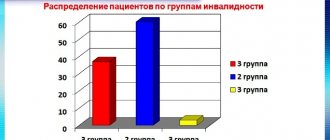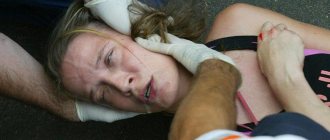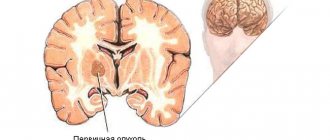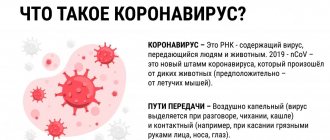Surely many, upon hearing the word “epilepsy,” will say that this is a mental illness and should be treated by a psychiatrist. This is fundamentally wrong. If you suspect epilepsy, you need to see a neurologist, since epileptology, the science that studies epilepsy, is a branch of neurology.
A child with epilepsy can be observed by a psychiatrist if he has mental disorders caused by epilepsy itself or concomitant pathologies. But epilepsy itself is treated by a neurologist.
What examination helps identify epilepsy?
Epilepsy is a chronic disease in which foci of excessive excitation appear in the brain. It can occur at any age. According to the World Health Organization, about 50,000,000 people worldwide suffer from epilepsy. The proportion of the population with active epilepsy (and therefore in need of treatment) in 2021 ranges from 4 to 10 per 1000 people.
The only method for reliably detecting epilepsy is an EEG - a recording of the electrical activity of the brain, which makes it possible to detect these foci.
Additional methods - MRI, computed tomography, genetic studies help to carry out differential diagnosis, for example, to identify the site of hemorrhage or tumor, the presence of hereditary pathology.
A typical EEG session lasts 20-30 minutes and quite often does not reveal any signs of disease in a child or adult, even if there were suspicious symptoms.
Therefore, if there is a suspicion of epilepsy, video EEG monitoring of sleep and a long period of wakefulness is carried out with functional tests (synonyms are video EEG monitoring of night sleep, video EEG monitoring of daytime sleep, video EEG monitoring of night sleep, video EEG monitoring of 24 hours, and so on), which allow you to provoke an attack. Parents are often worried when they hear that the doctor will try to cause an attack, however, sometimes this is the only way to make a completely reliable diagnosis.
Parents should be aware that most children whose EEG shows epileptiform activity do not have epilepsy . They are at risk, but often do not suffer a single attack in their entire lives and do not need any treatment. Moreover, 10% of people have experienced a convulsive episode at least once in their lives, but they are not diagnosed with epilepsy, since one of the main criteria for making such a diagnosis is the regularity of attacks.
Manifestations of epilepsy are not:
- Sleepwalking (sleepwalking). Sleepwalking in itself is not a manifestation of epilepsy. If any other symptoms are present, they must be considered together.
- Headache. Headache is a syndrome that can indicate the presence of a variety of diseases and must also be considered in conjunction with other symptoms.
- Hyperkinesis, tics. Hyperkinesis is a violent stereotypical movement; in children it can be a manifestation of a whole group of diseases and is not always an indication for an EEG.
- Bedwetting (enuresis). It occurs both in children with epilepsy and in those who do not suffer from it.
MRI of the brain shows epilepsy?
On MRI images, arrows indicate areas of cortical dysplasia - a congenital disorder in the distribution of cells in the gray and white matter of the brain.
Before the study, a person is worried: “Does MRI show epilepsy?” The diagnostic method under discussion will determine the causes of provoked seizures, regardless of how long ago they appeared, or will demonstrate the absence of morphological rearrangements of intracranial structures. The tomograph produces images of the brain with a thickness of 1 mm. Thanks to such precision, minimal changes are visible, which gives a chance to begin treating organic pathology in the early stages.
Structural disorders of the nervous tissue can cause epileptic syndrome. All pathological areas will be visible on the MRI image. Images are obtained due to the influence of magnetic radiation on water dipoles. The strength of the reflected signal depends on how saturated the tissues are with fluid. A computer program processes the data, and the doctor gets a detailed picture of the brain structures.
Indications for MRI are the following conditions:
- temporary loss of consciousness;
- uncontrolled contractions of muscles of different groups;
- changes in auditory, visual perception or the functioning of other senses;
- loss of orientation in time, space or identity;
- violent emotional grimaces, etc.
Diagnosing epilepsy using MRI has a number of advantages:
- no pain or danger during the procedure;
- there are practically no age restrictions when scanning in hospitals (images are not performed on children under 4 weeks old or pregnant women in the first trimester);
- the method shows all lesions that could cause changes in the EEG (tumors and other changes).
Also in our center it is possible for one of the parents to be present with the child during the scan in the tomograph room.
What should parents pay attention to?
The first and most important thing is to remember that epilepsy is not always seizures with loss of consciousness. In epilepsy, seizures can be local (local): twitching of the arm, leg, corner of the mouth, or they may be completely absent. Seizures can be manifested by blinking, drooling, redness of the face, episodes of “switching off” that the child does not remember, changes in behavior (the appearance of aggression, fear).
Often the child's status may only be developmental delay.
Not every seizure can be a manifestation of epilepsy that requires serious treatment. Convulsive syndrome is the body’s response to intoxication, endocrine diseases, fever, cerebrovascular accidents, increased intracranial pressure and other numerous pathologies.
Parents should be alert to:
- Asymmetry. Only one arm or leg, one half of the face twitches, and one half of the torso is involved in the process.
- Stereotyping of attacks.
- Repeatability.
- Spread of twitching, transition from one part of the body to another.
If you have any suspicion, you should try to “catch” the attack on video. Place a video camera in your child's room and record his periods of wakefulness and sleep. If you find something suspicious, take the note with you to your doctor’s appointment. Sometimes a recording of an attack becomes the only and main evidence of a problem, however, the doctor will always consider the attack in conjunction with other symptoms: developmental delay, motor and neurological disorders, data from other examinations.
Signs of epilepsy on MRI of the brain
On a magnetic resonance scan, arrows indicate areas of sclerosis of the hippocampus.
MR images can show the causes of epileptic syndrome. In the case of the latter, seizures or other types of paroxysms are caused by a specific brain pathology, which is visible on the tomogram. The disease can often be treated with medication or surgery, after which the seizures are likely to go away on their own.
In cases of true epilepsy, an MRI may show no changes at all. Another likely scenario is that the method will reveal findings that until now scientists at epileptological centers have not been able to say with certainty that it is these rearrangements that cause abnormal excitability. For example, it remains unknown whether hippocampal sclerosis is a consequence of the disease or its cause.
Types of seizures and aura in epilepsy.
The international classification of epileptic seizures describes more than 20 types of seizures. In a simplified form, the classification looks like this:
- Partial (local) attacks occurring without disturbances of consciousness.
During these attacks, convulsive twitching involves some part of the body, can move from arm to leg or to the face and vice versa, but does not spread to the entire body. Sometimes attacks occur without convulsions. The manifestations of such focal attacks are varied: facial redness, drooling, flashes before the eyes, ringing in the ears. There is a special type of epilepsy - Jacksonian, in which seizures first seize one part of the body, then move to another in a certain sequence.
- Partial seizures occurring with disturbances of consciousness.
During these attacks, automatisms are common: a person unfastens buttons, begins to chew something, repeats the same phrase “what is it,” “I feel bad,” laughs or grimaces.
- Partial seizures with generalization.
These attacks begin as described above, then progress to a convulsive attack that involves the entire body.
- Generalized seizures.
These include non-convulsive and convulsive seizures.
Absence seizures are a type of non-convulsive seizure in which a person’s consciousness turns off for a short period of time. They may also be accompanied by automatisms and vegetative symptoms (redness of the face, drooling).
A generalized tonic-clonic seizure appears as a full-body seizure with loss of consciousness and amnesia (the person, upon regaining consciousness, does not remember the seizure itself or the events immediately preceding the seizure).
- In addition, there are atypical seizures that cannot be classified into any of the groups.
Sometimes an epileptic attack is preceded by an aura - a sensory sensation in the form of sound, color, smell, unpleasant taste, dizziness, mood changes, and abdominal discomfort.
The aura can manifest itself independently, without an attack. The type of aura is determined by the location of the epileptic focus in the cerebral cortex.
Origin and clinical significance
In a normal brain, the processes of cortical excitation and inhibition must be balanced. In this case, the cortex generates normal regular electrical activity during wakefulness, such as alpha rhythms, beta rhythms and midfrontal theta rhythm, which are recorded from the scalp due to the synchronous activation of millions of neurons.
Main types of epileptiform activity (Zenkov L.R., 2002)
If the inhibition-excitation balance is disrupted so that excitation begins to prevail over inhibition and neural networks become hypersynchronized, the cortex begins to generate abnormal electrical activity called paroxysms. These abnormalities can in most cases be recorded from the scalp using conventional EEG in the form of various electrographic patterns (for example, spikes).
In extreme cases, cortical hypersynchronization in an epileptogenic focus can lead to a seizure, a complex of stereotypical and uncontrollable seizure-like behavioral changes such as twitches and convulsions, accompanied by a transient loss of consciousness. The severity of the seizures can vary: some patients may shake and fall, while others may only have a seizure noticed by the most attentive family members.
Prognosis for epilepsy.
Epilepsy is always assessed by a doctor as a complex of symptoms.
Benign forms of epilepsy often require only observation and may resolve on their own with age.
In other cases, epilepsy and associated pathologies may require serious treatment, and the prognosis will depend on the severity of the underlying disease. Some of these pathologies can be cured completely, for example, by removing a tumor or eliminating the consequences of an injury. Then the attacks will disappear. In other cases, lifelong medication and work with a psychologist are required.
What to do and what not to do during an attack?
During an attack you must:
- if a person’s position does not threaten his life (for example, there is no risk of falling from a height, into water, etc.), then it is better not to touch him, not to try to hold his head or body in place;
- remove sharp, hard objects from reach to avoid the possibility of injury;
- if possible, place something soft under your head;
- if necessary, unbutton the collar, untie the belt, loosen the tie;
- observe.
Be prepared for respiratory arrest, bloody foam at the mouth, and involuntary urination.
Important ! During convulsions, you should not hold a person in place, try to put a spoon or a wooden stick in his mouth, or try to open his teeth with force. This measure will not prevent tongue retraction, and too aggressive an effort can break a person’s teeth, jaw, or object that the person providing assistance is trying to put in his mouth. In this case, the fragments will get into the mouth and may end up in the respiratory tract.
If you notice the beginning of an attack, note the time. If the attack lasts more than 5 minutes, call an ambulance. Have someone record the attack on video so you can show it to your doctor later. This can be very important, especially for a person who is having a seizure for the first time or for a person who is unaware of their epilepsy.
As a rule, after an attack, a person does not come to his senses immediately, within 10–15 minutes. Breathing usually returns on its own, so there is no need for artificial respiration. There is also no need to offer water or food during this period.











